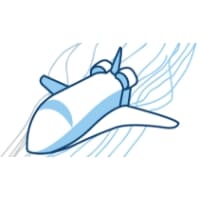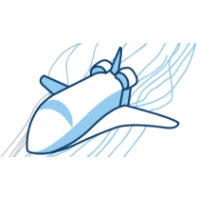Courses by Software
Courses by Semester
Courses by Domain
Tool-focused Courses
Machine learning
POPULAR COURSES
Success Stories
Week 5.1 - Mid term project - Solving the steady and unsteady 2D heat conduction problem
2-D steady state is solved first using the three methods. The three methods are formulated in MATLAB as follows. close all clear all clc % Solving steady state 2D heat conduction equation % Domain is a square of length equal to one n=20; % Number of nodes in x and y direction % Discretization of domain x=linspace(0,1,n);…
Jaswanth Kalyan Kumar Alapati
updated on 22 Jul 2021
2-D steady state is solved first using the three methods. The three methods are formulated in MATLAB as follows.
close all
clear all
clc
% Solving steady state 2D heat conduction equation
% Domain is a square of length equal to one
n=20; % Number of nodes in x and y direction
% Discretization of domain
x=linspace(0,1,n); % 20 nodes in x-direction
dx=x(2)-x(1); % grid spacing in x-direction
y=linspace(0,1,n); % 20 nodes in y-direction
dy=y(2)-y(1); % grid spacing in y-direction
T_old=ones(n,n)*300; % Initializing temperature as 300 K everywhere - Initial guess values
T_old(:,1)=400; % Left boundary is at 400 K
T_old(:,n)=800; % Right boundary is at 800 K
T_old(1,:)=600; % Top boundary is at 600 K
T_old(n,:)=900; % Bottom boundary is at 900 K
% Temperature at the corners is average of the intersecting side temperatures
T_old(1,1)=500;
T_old(1,n)=700;
T_old(n,1)=650;
T_old(n,n)=850;
T_new=T_old; % T_new is temperature for next iteration
tolerance=0.0001;
error=1;
omega=1.72; % Relaxation factor for SOR method
counter1=0; % Counter to count iterations for Jacobi method
counter2=0; % Counter to count iterations for gauss siedal method
counter3=0; % Counter to count iterations for SOR method
i=2; % To select the method for solving
% Jacobi method
if (i==1)
while(error>tolerance)
for i=2:n-1
for j=2:n-1
T_new(i,j)=(0.5/(dx^2+dy^2))*(((T_old(i-1,j)+T_old(i+1,j))*dy^2)+((T_old(i,j-1)+T_old(i,j+1))*dx^2));
counter1=counter1+1;
end
end
error=max(max(abs(T_old-T_new)));
T_old=T_new;
end
end
% Gauss-siedal
if (i==2)
while(error>tolerance)
for i=2:n-1
for j=2:n-1
T_new(i,j)=(0.5/(dx^2+dy^2))*(((T_new(i-1,j)+T_old(i+1,j))*dy^2)+((T_new(i,j-1)+T_old(i,j+1))*dx^2));
counter1=counter1+1;
end
end
error=max(max(abs(T_old-T_new)));
T_old=T_new;
end
end
% SOR Method on Gauss-siedal
if (i==3)
while(error>tolerance)
for i=2:n-1
for j=2:n-1
T_new(i,j)=T_old(i,j)*(1-omega)+omega*((0.5/(dx^2+dy^2))*(((T_new(i-1,j)+T_old(i+1,j))*dy^2)+((T_new(i,j-1)+T_old(i,j+1))*dx^2)));
counter3=counter3+1;
end
end
error=max(max(abs(T_old-T_new)));
T_old=T_new;
end
end
[X,Y]=meshgrid(x,y);
contourf(X,(1-Y),T_old,'ShowText','on');
xlabel('x');
ylabel('y')
title('2D Steady state temperature distribution using Jacobi');The colormap of the plot is changed to jet and are as follows.
1. Plot obtained using Jacobi method
_1626938692.png)
2. Plot obtained using Gauss-siedal method
_1626938749.png)
3. Plot obtained using SOR on Gauss-siedal method
_1626938830.png)
For the SOR method, the value of omega is changed to find the number of iterations it takes to solve. The number of iterations is less for omega=1.72 for this problem.
The number of iterations it took to solve steady-state heat transfer is as follows.
Jacobi method, counter1 =267300
Gauss-siedal, counter2 =142884
SOR on gauss-siedal, counter3 =18792
The MATLAB script to solve the unsteady heat transfer using the explicit method is as follows.
close all
clear all
clc
% Solving Unsteady state 2D heat conduction equation by explicit method
% Domain is a square of length equal to one
n=20; % Number of nodes in x and y direction
% Discretization of domain
x=linspace(0,1,n); % 20 nodes in x-direction
dx=x(2)-x(1); % grid spacing in x-direction
y=linspace(0,1,n); % 20 nodes in y-direction
dy=y(2)-y(1); % grid spacing in y-direction
alpha=1.5; % Thermal diffusivity
% For stability (alpha*dt*2/dx^2)<=0.5 so dt<=(dx^2/4/alpha)
dt=0.0003; % Time step
nt=2100; % Number of time steps
T_time=ones(n,n)*300; % Initial temperature as 300 K everywhere at t=0
% Boundary conditions
T_time(:,1)=400; % Left boundary is at 400 K
T_time(:,n)=800; % Right boundary is at 800 K
T_time(1,:)=600; % Top boundary is at 600 K
T_time(n,:)=900; % Bottom boundary is at 900 K
% Temperature at the corners is average of the intersecting side temperatures
T_time(1,1)=500;
T_time(1,n)=700;
T_time(n,1)=650;
T_time(n,n)=850;
T_new=T_time; % Initializing temperature for next time step
for k=1:nt
for i=2:n-1
for j=2:n-1
T_new(i,j)=T_time(i,j)+(alpha*dt/dx^2)*((T_time(i-1,j)-2*T_time(i,j)+T_time(i+1,j))+(T_time(i,j-1)-2*T_time(i,j)+T_time(i,j+1)));
end
end
T_time=T_new;
end The MATLAB script to solve unsteady heat transfer using the three different methods (Implicit) is as follows.
close all
clear all
clc
% Solving Unsteady state 2D heat conduction equation by explicit method
% Domain is a square of length equal to one
n=20; % Number of nodes in x and y direction
% Discretization of domain
x=linspace(0,1,n); % 20 nodes in x-direction
dx=x(2)-x(1); % grid spacing in x-direction
y=linspace(0,1,n); % 20 nodes in y-direction
dy=y(2)-y(1); % grid spacing in y-direction
alpha=1.5; % Thermal diffusivity
% For stability (alpha*dt*2/dx^2)<=0.5 so dt<=(dx^2/4/alpha)
dt=0.0003; % Time step
nt=2100; % Number of time steps
T_time=ones(n,n)*300; % Initial temperature as 300 K everywhere at t=0
% Boundary conditions
T_time(:,1)=400; % Left boundary is at 400 K
T_time(:,n)=800; % Right boundary is at 800 K
T_time(1,:)=600; % Top boundary is at 600 K
T_time(n,:)=900; % Bottom boundary is at 900 K
% Temperature at the corners is average of the intersecting side temperatures
T_time(1,1)=500;
T_time(1,n)=700;
T_time(n,1)=650;
T_time(n,n)=850;
T_old=T_time; % Initializing temperature for next iteration
T_new=T_time; % T_new is temperature for next iteration
tolerance=0.0001;
error=1;
omega=1.72; % Relaxation factor for SOR method
counter1=0; % Counter to count iterations for Jacobi method
counter2=0; % Counter to count iterations for gauss siedal method
counter3=0; % Counter to count iterations for SOR method
i=3; % To select the method for solving
% Constants used in Implicit formulation
c=(alpha*dt)/dx^2; % constant value
term1=1/(1+4*c);
term2=c*term1;
% Jacobi method
if (i==1)
for k=1:nt
while(error>tolerance)
for i=2:n-1
for j=2:n-1
T_new(i,j)=term1*T_time(i,j)+term2*(T_old(i-1,j)+T_old(i+1,j)+T_old(i,j-1)+T_old(i,j+1));
end
end
error=max(max(abs(T_old-T_new)));
T_old=T_new;
end
T_time=T_new;
error=1;
end
end
% Gauss-siedal
if (i==2)
for k=1:nt
while(error>tolerance)
for i=2:n-1
for j=2:n-1
T_new(i,j)=term1*T_time(i,j)+term2*(T_new(i-1,j)+T_old(i+1,j)+T_new(i,j-1)+T_old(i,j+1));
end
end
error=max(max(abs(T_old-T_new)));
T_old=T_new;
end
T_time=T_new;
error=1;
end
end
% SOR Method on Gauss-siedal
if (i==3)
for k=1:nt
while(error>tolerance)
for i=2:n-1
for j=2:n-1
T_new(i,j)=T_old(i,j)*(1-omega)+omega*(term1*T_time(i,j)+term2*(T_new(i-1,j)+T_old(i+1,j)+T_new(i,j-1)+T_old(i,j+1)));
end
end
error=max(max(abs(T_old-T_new)));
T_old=T_new;
end
T_time=T_new;
error=1;
end
endFor Unsteady state heat transfer, the value of dt is chosen as 0.0003 based on the stability criteria as follows.
The value of dx and dy in this problem is equal. i value is used for selecting the method (Jacobi or gauss-siedal or SOR).
Leave a comment
Thanks for choosing to leave a comment. Please keep in mind that all the comments are moderated as per our comment policy, and your email will not be published for privacy reasons. Please leave a personal & meaningful conversation.
Other comments...
Be the first to add a comment
Read more Projects by Jaswanth Kalyan Kumar Alapati (8)
Week 1- Mixing Tee
This assignment aims to evaluate the mixing effectiveness of a Tee joint with two different outlet pipe lengths, namely small and long. The required Tee geometry is provided, and the interior volume for CFD analysis is extracted as shown below. Tee geometry with shorter outlet pipe: Extracted…
03 Sep 2022 08:13 PM IST
Week 12 - Validation studies of Symmetry BC vs Wedge BC in OpenFOAM vs Analytical H.P equation
Unlike in the previous assignment, where the simulation is performed using a transient solver icoFoam, the simulation is carried out using a steady-state solver simpleFoam since the emphasis is on the steady-state flow field. This assignment aims to compare the boundary conditions of Wedge and Symmetry…
11 Jan 2022 11:09 AM IST
Week 11 - Simulation of Flow through a pipe in OpenFoam
The following is the simulation of a laminar flow of an incompressible fluid through the pipe in OpenFoam. The following figure depicts the physical situation of the flow. For a laminar flow, the hydrodynamic length, , where is pipe diameter, and is Reynolds number…
07 Jan 2022 10:13 AM IST
Week 9 - FVM Literature Review
Finite Volume Method (FVM) is a numerical technique for solving partial differential equations governing the phenomena. The method involves discretizing the domain into smaller volumes. These control volumes are connected by common faces. The governing equation in integral form is applied for all the control volumes followed…
26 Dec 2021 07:15 AM IST
Related Courses





Skill-Lync offers industry relevant advanced engineering courses for engineering students by partnering with industry experts.
Our Company
4th Floor, BLOCK-B, Velachery - Tambaram Main Rd, Ram Nagar South, Madipakkam, Chennai, Tamil Nadu 600042.
Top Individual Courses
Top PG Programs
Skill-Lync Plus
Trending Blogs
© 2025 Skill-Lync Inc. All Rights Reserved.









